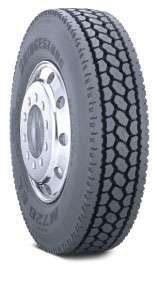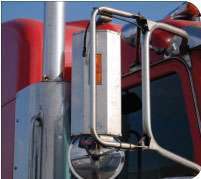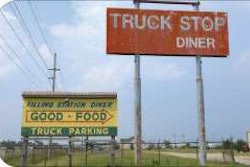With all the fuel saving products in the marketplace, how do you know what works? There is no simple answer, but sorting through the hype ultimately comes down to physics.
 Tread design and type of rubber compound account for 40 percent of a tire’s rolling resistance.
Tread design and type of rubber compound account for 40 percent of a tire’s rolling resistance.For a fuel mileage device or strategy to improve fuel economy, it has to have a positive impact on one of the following factors. If you’re unable to determine that, check for third-party independent testing. You also might get opinions from customers who have used the product successfully.
Aerodynamic drag is the top factor affecting how much fuel your truck uses at highway speeds. The easiest way to reduce drag is to slow down. Every 1 mph you slow down equates to 1⁄10 a mile per gallon improvement. Just slowing down also will positively affect the next two factors on this list, as well.
Fuel economy can vary widely between classic and aerodynamic designs. At 65 mph, the difference can be 1 mile per gallon. That could equal a $10,000 yearly savings for the aerodynamic truck. The next time you’re buying a truck, think twice before choosing a square nose.
Rolling resistance comes primarily from tires. Roughly 60 percent of the rolling resistance in any tire comes from sidewall design, the remaining 40 percent from tread design and the rubber compound. Choosing a tire with lower rolling resistance could improve fuel mileage by as much as half a mile per gallon.

Tire position also can affect rolling resistance. Trailer tires have the greatest impact, followed by drive tires and then steer tires. Wheel alignment and tire balance can also affect rolling resistance.
 If your rig isn’t as aerodynamic as it could be, see if improvements such as rounded mirrors or a trailer gap reducer would lower air resistance. For more ideas about aerodynamics and objective estimates of fuel savings, visit the U.S. Environmental Agency’s SmartWay website, epa.gov/smartway, and search for “truck aerodynamics.”
If your rig isn’t as aerodynamic as it could be, see if improvements such as rounded mirrors or a trailer gap reducer would lower air resistance. For more ideas about aerodynamics and objective estimates of fuel savings, visit the U.S. Environmental Agency’s SmartWay website, epa.gov/smartway, and search for “truck aerodynamics.”The lower the tire’s rolling resistance number, the better the fuel economy. You can get an idea of these ratings and their relationship to fuel savings by looking at Michelin’s online calculator that compares any tire to a Michelin replacement. Visit michelintruck.com, search “fuel savings calculator,” click first result, then “Rolling Resistance Comparison” on the left.
Mechanical resistance is in play in your driveline. Roughly 15 percent of available horsepower is lost through the transmission, driveshaft, U-joints, carrier bearings, differentials, power divider and wheel bearings. Reduce mechanical resistance and you’ll increase horsepower at the wheels and improve fuel economy.
Oil is one factor in this. For any driveline component, choose the lightest synthetic oil approved for use. Direct drive transmissions also have lower mechanical resistance than overdrive transmissions. Also choose the smallest, lightest wheel and tire assembly. Have your truck inspected and measured for correct driveline angles.
Thermal efficiency is a measure of your engine’s ability to convert fuel to horsepower. Before making any modifications to your engine, ensure:
• Valves are properly set;
• Intake and charge air cooler system is free of leaks;
• All air, fuel and oil filters are clean and of the proper micron size for your engine.
Use high-flow air filters, high-flow exhaust components and synthetic oils. ECM settings can be tweaked and tuned to improve engine performance and fuel economy as well.
Next month: Tips on how to test fuel mileage products on your own.













